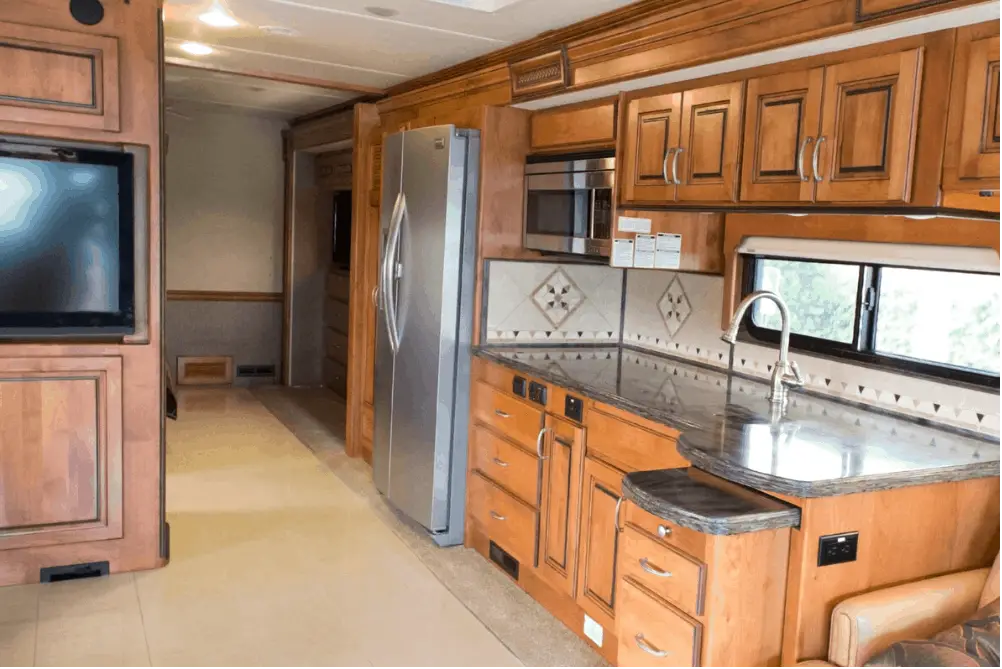If you are an owner of an RV Fridge, then a lot of questions might arise in your mind. For example, if you can run an RV Fridge without a battery. In this article, I will talk about all the details regarding types of RV fridges and if they can run without batteries or not.
Batteries power the control board and assist ignition. To regulate the gas valve, the control board requires a 12 Volt DC battery. The gas valve will close if there is no electricity. Without the battery, you cannot use propane gas to fuel the burner that heats the refrigerant or provides cooling to the system. Therefore, RV refrigerators will not work without them.
In hindsight, it is possible to run some models of RV Fridges on a limited amount of time without the battery. But it is not possible to do forever. So, if you are wondering, will RV fridge work without battery, then hopefully, you will have a clear idea regarding all the information you need after going through this article.
Types of Power Sources Used By RV Fridges
There are two types of RV Fridges in general. Both of the fridges can run on different battery inputs. Power outputs of 12V battery (DC) or 240V battery (AC) can be used for 2-way Refrigerators. For 3-way refrigerators, Propane gas can also work as a power input to run the batteries or RV Fridge.
Direct Current (DC)
The type of electricity that is usually found in RV refrigerators is Direct Current. All RV refrigerators can connect to Direct Current (DC) power and consume power easily.
Although there are some issues regarding DC power supply. Because DC is insufficient to power larger RV refrigerators, you’ll need an inverter to convert your DC power to AC.
Alternating Current (AC)
AC stands for alternating current, which in AC circuits alternates direction with the voltage, sometimes reversing due to the changing current direction.
You use Alternating Current (AC) for various uses in your home. For example, many household devices and connections have AC flowing through them. If you plan to connect your RV fridge to the electrical system of your home, then you connect it to AC power.
Liquid Petroleum Gas (LP)
LP gas is made up of compressed vapor gases, including propane. The vapor of LP gas is a byproduct of natural gas processing and refining, where it is compressed into a liquid state for use as an energy source.
You can use LP gas in case of electricity being unavailable or if there is a shortage of supply of electricity. It acts as a good substitute for AC and DC.
2-Way Refrigerator Battery
The compressor system in 2-way refrigerators, also known as 12-volt refrigerators, allows them to operate efficiently in high-temperature environments. Depending on the model, this type of RV refrigerator can operate on either a 12V battery (DC) or 240v mains power (AC.)
These refrigerators are typically smaller in size than absorption refrigerators, putting a strain on your coach battery and necessitating the use of supplemental solar energy to keep your battery charged while off the grid.
3-Way Refrigerator Battery
3 Way refrigerators are also known as absorption refrigerators. They operate on 12/24 direct current, 240V mains power (AC), or LP gas. Despite the fact that they lack the cooling power of a two-way fridge, they are more energy-efficient and can run on a single 9kg gas tank for several weeks.
These refrigerators are the preferred option for those who prefer to store for a long period of time and spend their time in remote locations without access to electricity.
The Amount of Power Consumption of RV Fridges
RV Fridges consume a considerable amount of volt to operate. A regular RV Fridge requires almost 600 Watts to start. For running properly, it needs around 150-180 Watts, depending on the size of the Fridge. Furthermore, the majority of refrigerators will require about 15 to 20 Watts.
A double-door refrigerator that is suitable for use in an RV would typically have a startup amp of about 7-8 amps. The other amps of the operation are considerably lower than the first amps generated. A functioning refrigerator consumes around 2-4 amps on average.
The amps drawn by the RV fridge while defrosting will be about 1.20-2 amps. The refrigerator generates less than 0.5 amps when the only thing operating is the evaporator fan.
There may be certain exclusions, depending on the size of your refrigerator, its age, and the brand and kind. The fridge may also be powered by a 120-volt power source, a dc battery, or even propane. The amps drawn are also affected by the method of power supply. A refrigerator that runs on LP requires around 3-4 amps to operate.
Running RV Fridges on Propane
It is necessary to have at least a 10.5 V battery power to turn on propane refrigeration, even if it does not require electrical power to operate. This energy boost is required in order to open the gas base and ignite the ignitor. If this energy boost is not provided, then the refrigerator would not operate.
Here are the steps to running your RV fridge on propane:
Ready your RV Fridge to run on Propane
In order to run a propane-powered RV refrigerator, your RV must be perfectly level. A
level should be placed in your RV refrigerator or on the counter next to it to ensure that this is the case.
You will firstly need a small amount of direct current (DC) to start the Propane refrigerator. So it is vital for you to make sure to fully charge your battery.
Light up Propane to Power the RV Fridge for Storing
As soon as you are ready to begin using propane to power your refrigerator, you must first locate the control panel for it. The location and appearance of the control panel will vary depending on the model.
Different models have different sets of controls. So, you should always follow your user manual according to the model you have. Otherwise, it won’t be possible to properly light up the propane.
Setting the Temperature of the Fridge
Once the light of the propane has been ignited, you can use the Thermostat to regulate the temperature of your RV refrigerator. It should now be able to run entirely on propane as well.
Although it won’t be available for use right away. It will take at least a few hours to cool down to the temperature you specify. However, it could take up to twenty-four hours or more. You should start your refrigerator the day before you plan to fill it if possible.
Amount of Propane an RV Fridge Uses
Depending on the size and age of your RV refrigerator, the amount of propane it consumes can vary significantly. A newer RV fridge consumes less propane as it tends to be more efficient than an older model.
Depending on the type, a modern RV refrigerator with an interior capacity of about 10 to 12 cubic feet will use around 1.5 pounds of propane each day. This amounts to nearly 1,400 BTUs per hour of operation.
Advantages of Running RV Fridges on Propane
There is no requirement for electrical power. You can safely store food and medicines without any problems with power interruptions. You can travel to places far from your home without having to worry. Fortunately, your propane refrigerator will keep your supplies safe.
Since there are no moving parts in a propane refrigerator, nothing will wear out over time. With the current price of propane, a refrigerator of this type is significantly less expensive to operate than a traditional ice cellar.
The initial cost of purchasing a propane gas refrigerator is significantly higher than the cost of purchasing an electric refrigerator, but it is less expensive than the cost of purchasing a 12VDC refrigerator.
Conclusion
It is possible to run RV fridges without batteries, but some specific models can do so for only a short amount of time. In reality, you can’t run RV Fridges without batteries for any usable amount of time.
But you can run RV fridges using Propane, which would not require any electricity. Hopefully, this article has cleared all your doubts regarding will rv fridge work without battery. Thank you for reading.


